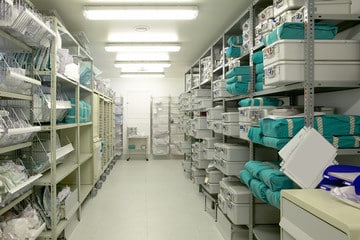If there is a profession that encapsulates the need to keep everything worked with organized, it's the medical world. After all, the lives of patients depend not only on the people who work with them but also on the tools and supplies they use to do their work need to always be close and ready to use.
There are many factors that may be affecting the efficiency of your medical screening process. Reducing the turnaround time is vital for every healthcare facility - you need to find ways to reduce it. A hospital screen will help tremendously because they are convenient and portable. It is very versatile and can be used in different departments to prevent cases of cross-contamination.
If there was ever a business that personified the maxim, "Everything in its place," it's medicine. Beginning with a product like Capsa Hospital Supply Carts is a good start. This article will keep you in good stead, from start to finish.
A Place for Everything
It doesn't matter what department a clinician works in, medicine is a field that requires a lot of equipment. Making matters more complicated is that much of the material used is both small and often dangerous in many cases.
For this reason, hospital supplies should be kept in a secure place that can be kept close at hand and out of reach by unauthorized persons. Further, if a supply cart needs to be used by multiple persons, it should be easily transportable from one location to another.
Good quality hospital trolleys will more than suffice for this task.
A Bag to Grab
Procedures that clinicians perform can be as different at night and day. Fortunately, the nature ofmedical supplies allows them to be categorized by function. For example, a trach kit will require having a scalpel, tubing, and other items that can be kept in a separate bag inside of a cart.
Dedicated Space
It doesn't matter how specialized equipment and supplies are, if they are not returned to where they can be found, they might as well not be kept. For this reason, whatever the supply might be, it should be kept in space, shelf, or any other location that is completely dedicated to that supply, equipment, or application. For example, resuscitation equipment can be kept in one place, either by itself or the different elements can be kept separate, such as tubing kept with other tubing.
Making It Clear
What good is keeping equipment separated if nobody knows what is inside of a bag or box? For that reason, whether a container for supplies is a box, drawer, bag, or anything else should be clearly labeled inside or clear so that it can be readily seen.
Store by Category
Equipment and supplies should always be kept separate and together by category. For example, it makes no sense to have a suture kit ready to use if it has needles but no suture materials. Likewise, what good would a crash kit be without gauze and wipes?
Consider what items would ordinarily be used together and make sure they are stored that way.
Label Everything Clearly
Use labels to mark whatever should be on a shelf and what goes in each bin. Even if you use a transparent storage device, it saves time and headaches when it comes time finding something and putting it back.
Remove Packaging
Things must be clearly identified with what it is, but it is also essential to remove wrappers and boxes before supplies are stored. This not only saves space, but it also prevents the hassle of tearing through packaging that isn't needed. For example, store latex gloves in a zip lock bag rather than a bulky box.
With organized methods to keep supplies organized and handy, it's easier to find things when they are needed. Good storage methods also makes them eaiser to inventory when they need to be reordered.

